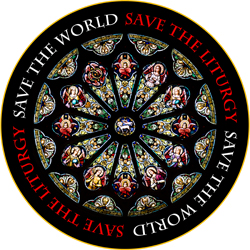An interesting piece by Peter Steinfels about a set of sculptural Stations with Christ's POV.
http://www.nytimes.com/2008/03/01/us/01beliefs.html?sq=roman%20catholic&st=nyt&scp=1&pagewanted=all
He talks about the change over the past century in the artistic POV that is brought to bear on the creation of the 14 devotional paintings/plaques/statues.
And of course he sets in opposition the old fashioned "crowded with Roman soldiers and jeering or appalled onlookers, perhaps set against someone’s impression of first-century Jerusalem" and the modern, (in this quote, modern as in dating from 1918,) where the " figures were few and without background; the compositions were simple and formal, not theatrical. Rather than dictating an emotional response [leaving] space for the devotee’s own thoughts."
There is a touch of condescension, I think, toward more realistic, more detailed depictions, inherent in the praise for abstraction's requiring the devotee's participation, no?
Only the kitschiest, most simplistic "realistic" art dictates a specific emotional response.
There are many more traditional renderings that leave ample room to reflect on different aspects of this devotion, that in fact invite a multiplicity of reactions precisely because of their immense detail... Oh, look that figure half turned away, would that be me? would I have tried to let myself off the hook because, after all, I didn't stand there jeering?
That must be Mary, but she seems almost calm and resigned, wouldn't I have been hysterical? or is that what absolute grief feels like? is that what holy grief feels like, looking unflinchingly at her suffering Son, rather than turning inward and focusing on her own vicarious suffering? could I ever do that?
And I have seen presentation of the Stations, sometimes very beautiful, that are so abstract that they invite no emotional response whatever, or at least none that relate in any way to the passion and death of the Savior of the World, (which may be the point, and it does their creators no credit if it is.)
And presenting the evolution of art, whether religious or not, whether plastic or not, there is seldom any acknowledgement of the fact that realistic detail (or attempts at realistic detail, as Steinfels put it, some artists would naturally be able to present on the most uninformed and fanciful "impression of first-century Jerusalem,") were a great deal more necessary before the ubiquity of images that is modern life.
A movie maker does not need the same kind of establishing shots for many, many milieus that, say, the creators of Nanook of the North did. Or rather, his audience does not need them.
Modern readers are often impatient with a Dickens or a Fielding describing something that they have seen a thousand times.
Some good background..." on the history of the stations in art and ritual.Although medieval pilgrims to Jerusalem had traced what they considered Jesus’ final steps, they had done so without public ceremony, in order not to strain the tolerance of the city’s Muslim rulers and population. The practice of marking the stations with images and prayer really began in Europe and developed its modern form between the mid-15th and mid-18th centuries.
Over those three centuries, versions of the stations featured anywhere from 11 to 36 incidents in Jesus’ Passion. Of the 14 that ultimately constituted the standardized version, 6 have no basis in Scripture... but grew from popular lore, while other familiar episodes in the Gospels, like the scourging and mocking of Jesus, did not make the final cut.
The stations... are like much Christian art (and like much other religious art, one could add): no matter how brief and straightforward the original source, the believer, the preacher, the artist inevitably flesh it out, adding detail and new perspectives to help each devotee enter personally into the story and identify with the holy. "
And then finally, the admission as Steinfels paraphrases someone else, that, well, no, it is possible that those "centuries of stations [even if] crowded with Roman soldiers and jeering or appalled onlookers, perhaps set against someone’s impression of first-century Jerusalem" and that "the artist inevitably fleshes it out, adding detail and new perspectives to help each devotee enter personally into the story and identify with the holy" and maybe not ALL those resulting from the moldy old ways are "obvious and quickly depleted" they might be "profound and lasting."
Because they have, ummm.. lasted.
(Oh, and by the way, thanks for asking, they went well.)
Subscribe to:
Post Comments (Atom)




No comments:
Post a Comment